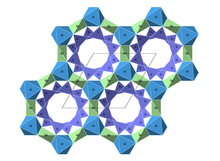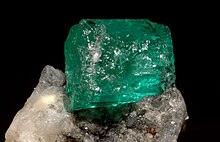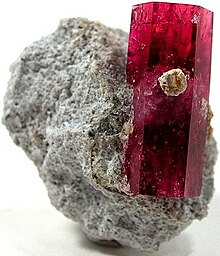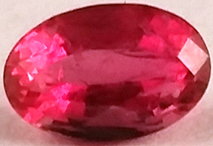Beryl
| Beryl | |
|---|---|
 | |
| General | |
| Category | Cyclosilicate |
| Formula (repeating unit) | Be3Al2Si6O18 |
| IMA symbol | Brl[1] |
| Strunz classification | 9.CJ.05 |
| Crystal system | Hexagonal |
| Crystal class | Dihexagonal dipyramidal (6/mmm) H-M symbol:(6/m 2/m 2/m) |
| Space group | P6/mcc |
| Unit cell | a= 9.21Å,c= 9.19 Å;Z= 2 |
| Identification | |
| Formula mass | 537.50 g/mol |
| Color | Green, blue, yellow, colorless, pink, and others |
| Crystal habit | Prismatic to tabular crystals; radial, columnar; granular to compact massive |
| Twinning | Rare |
| Cleavage | Imperfect on {0001} |
| Fracture | Conchoidalto irregular |
| Tenacity | Brittle |
| Mohs scalehardness | 7.5–8.0 |
| Luster | Vitreousto resinous |
| Streak | White |
| Diaphaneity | Transparent to translucent |
| Specific gravity | 2.63–2.92 |
| Optical properties | Uniaxial (−) |
| Refractive index | nω= 1.564–1.595 nε= 1.568–1.602 |
| Birefringence | δ= 0.0040–0.0070 |
| Pleochroism | Weak to distinct |
| Ultravioletfluorescence | None (some fracture-filling materials used to improve emerald's clarity do fluoresce, but the stone itself does not). Morganite has weak violet fluorescence. |
| References | [2][3][4][5]: 112 |
Beryl(/ˈbɛrəl/BERR-əl) is amineralcomposed ofberylliumaluminiumsilicatewith thechemical formulaBe3Al2Si6O18.[6]Well-known varieties of beryl includeemeraldandaquamarine.Naturally occurringhexagonalcrystalsof beryl can be up to several meters in size, butterminated crystalsare relatively rare. Pure beryl is colorless, but it is frequently tinted by impurities; possible colors are green, blue, yellow, pink, and red (the rarest). It is an ore source ofberyllium.[7]

Etymology[edit]
The wordberyl–Middle English:beril– is borrowed, viaOld French:berylandLatin:beryllus,fromAncient Greekβήρυλλοςbḗryllos,which referred to a 'precious blue-green color-of-sea-water stone';[2]fromPrakritveruḷiya,veḷuriya'beryl'[8][a] which is ultimately ofDravidianorigin, maybe from the name ofBelurorVelur,a town inKarnataka,southernIndia.[9]The term was later adopted for the mineral beryl more exclusively.
When the firsteyeglasseswere constructed in 13th-century Italy, the lenses were made of beryl (or ofrock crystal) as glass could not be made clear enough. Consequently, glasses were namedBrillenin German[10](brilin Dutch andbrillerin Danish).
Deposits[edit]
Beryl is a common mineral, and it is widely distributed in nature. It is found most commonly ingraniticpegmatites,but also occurs inmicaschists,such as those of theUral Mountains,and inlimestoneinColombia.[11]It is less common in ordinary granite and is only infrequently found innepheline syenite.Beryl is often associated withtinandtungstenore bodies formed as high-temperature hydrothermal veins. In granitic pegmatites, beryl is found in association withquartz,potassium feldspar,albite,muscovite,biotite,andtourmaline.Beryl is sometimes found inmetasomaticcontacts of igneous intrusions withgneiss,schist, orcarbonate rocks.[12]Common beryl, mined as beryllium ore, is found in small deposits in many countries, but the main producers are Russia, Brazil, and the United States.[11]
New England'spegmatiteshave produced some of the largest beryls found, including one massive crystal from theBumpus QuarryinAlbany, Mainewith dimensions 5.5 by 1.2 m (18.0 by 3.9 ft) with a mass of around 18 tonnes (20 short tons); it is New Hampshire's state mineral. As of 1999[update],the world's largest known naturally occurring crystal of any mineral is a crystal of beryl from Malakialina, Madagascar, 18 m (59 ft) long and 3.5 m (11 ft) in diameter, and weighing 380,000 kg (840,000 lb).[13]
Crystal habit and structure[edit]

Beryl belongs to thehexagonal crystal system.Normally beryl forms hexagonal columns but can also occur in massivehabits.As acyclosilicateberyl incorporates rings of silicate tetrahedra ofSi6O18that are arranged in columns along theCaxis and as parallel layers perpendicular to theCaxis, forming channels along theCaxis.[7]These channels permit a variety of ions, neutral atoms, and molecules to be incorporated into the crystal thus disrupting the overall charge of the crystal permitting further substitutions inaluminium,silicon,andberylliumsites in the crystal structure.[7]These impurities give rise to the variety of colors of beryl that can be found. Increasing alkali content within the silicate ring channels causes increases to therefractive indicesandbirefringence.[14]
Human health impact[edit]
Beryl is a beryllium compound that is a known carcinogen with acute toxic effects leading to pneumonitis when inhaled.[15]Care must thus be used when mining, handling, and refining these gems.[16]
Varieties[edit]
Aquamarine and maxixe[edit]

Aquamarine (fromLatin:aqua marina,"sea water"[17]) is a blue orcyanvariety of beryl. It occurs at most localities which yield ordinary beryl. The gem-gravelplacerdeposits ofSri Lankacontain aquamarine. Green-yellow beryl, such as that occurring in Brazil, is sometimes calledchrysolite aquamarine.[18]The deep blue version of aquamarine is calledmaxixe[19](pronounced mah-she-she).[20]Its color results from a radiation-inducedcolor center.[21]

The pale blue color of aquamarine is attributed to Fe2+.Fe3+ions produce golden-yellow color, and when both Fe2+and Fe3+are present, the color is a darker blue as in maxixe.[22][23]Decoloration of maxixe by light or heat thus may be due to the charge transfer between Fe3+and Fe2+.[24]
In the United States, aquamarines can be found at the summit ofMount Anteroin theSawatch Rangein central Colorado, and in the New England and North Carolina pegmatites.[25]Aquamarines are also present in the state ofWyoming,aquamarine has been discovered in theBig Horn Mountains,nearPowder River Pass.[26]Another location within the United States is theSawtooth RangenearStanley, Idaho,although the minerals are within a wilderness area which prevents collecting.[27]In Brazil, there are mines in the states ofMinas Gerais,[25]Espírito Santo,andBahia,and minorly inRio Grande do Norte.[28]The mines of Colombia,Skardu PakistanMadagascar, Russia,[25]Namibia,[29]Zambia,[30]Malawi,Tanzania,andKenya[31]also produce aquamarine.
Emerald[edit]

Emerald is green beryl, colored by around 2%chromiumand sometimesvanadium.[32][33]Most emeralds are highlyincluded,so their brittleness (resistance to breakage) is classified as generally poor.[34]
The modern English word "emerald" comes viaMiddle Englishemeraude,imported from modern French viaOld FrenchésmeraudeandMedieval Latinesmaraldus,fromLatinsmaragdus,fromGreekσμάραγδοςsmaragdosmeaning 'green gem'.[b]

Emeralds in antiquity were mined by theEgyptiansand in what is nowAustria,as well asSwatin contemporaryPakistan.[36]A rare type of emerald known as atrapiche emeraldis occasionally found in the mines ofColombia.A trapiche emerald exhibits a "star" pattern; it has raylike spokes of dark carbon impurities that give the emerald a six-pointed radial pattern. It is named for thetrapiche,a grinding wheel used to processsugarcanein the region.Colombian emeraldsare generally the most prized due to their transparency and fire. Some of the rarest emeralds come from the two main emerald belts in theEastern Rangesof the ColombianAndes:Muzo and Coscuezwest of theAltiplano Cundiboyacense,andChivor and Somondocoto the east. Fine emeralds are also found in other countries, such asZambia,Brazil,Zimbabwe,Madagascar,Pakistan,India,AfghanistanandRussia.In the US, emeralds can be found inHiddenite, North Carolina.In 1998, emeralds were discovered inYukon.
Emerald is a rare and valuable gemstone and, as such, it has provided theincentivefor developing synthetic emeralds. Both hydrothermal[37]andflux-growthsynthetics have been produced. The first commercially successful emerald synthesis process was that of Carroll Chatham.[38]The other large producer of flux emeralds was Pierre Gilson Sr., which has been on the market since 1964. Gilson's emeralds are usually grown on natural colorless beryl seeds which become coated on both sides. Growth occurs at the rate of 1 millimetre (0.039 in) per month, a typical seven-month growth run producing emerald crystals of 7 mm of thickness.[39]The green color of emeralds is widely attributed to presence of Cr3+ions.[40][22][23]Intensely green beryls from Brazil, Zimbabwe and elsewhere in which the color is attributed tovanadiumhave also been sold and certified as emeralds.[41][42][43]
Golden beryl and heliodor[edit]

Golden berylcan range in colors from pale yellow to a brilliant gold. Unlikeemerald,golden beryl generally has very few flaws. The term "golden beryl" is sometimes synonymous withheliodor(from Greekhēlios – ἥλιος"sun" +dōron – δῶρον"gift" ) but golden beryl refers to pure yellow or golden yellow shades, while heliodor refers to the greenish-yellow shades. The golden yellow color is attributed to Fe3+ions.[32][40]Both golden beryl and heliodor are used as gems. Probably the largest cut golden beryl is the flawless 2,054-carat(410.8 g) stone on display in theHall of Gems,Washington, D.C.,United States.[44]
Goshenite[edit]


Colorless beryl is calledgoshenite.The name originates fromGoshen, Massachusetts,where it was originally discovered. In the past, goshenite was used for manufacturing eyeglasses and lenses owing to its transparency. Nowadays, it is most commonly used for gemstone purposes.[45][46]
The gem value of goshenite is relatively low. However, goshenite can be colored yellow, green, pink, blue and in intermediate colors by irradiating it with high-energy particles. The resulting color depends on the content of Ca, Sc, Ti, V, Fe, and Co impurities.[40]
Morganite[edit]


Morganite, also known as "pink beryl", "rose beryl", "pink emerald" (which is not a legal term according to the new Federal Trade Commission Guidelines and Regulations), and "cesian (orcaesian) beryl ", is a rare light pink to rose-coloredgem-quality variety of beryl. Orange/yellow varieties of morganite can also be found, and color banding is common. It can be routinely heat treated to remove patches of yellow and is occasionally treated by irradiation to improve its color. The pink color of morganite is attributed to Mn2+ions.[32]
Red beryl[edit]

Red variety of beryl (the "bixbite" ) was first described in 1904 for an occurrence, itstype locality,at Maynard's Claim (Pismire Knolls), Thomas Range,Juab County,Utah.[47][48]The dark red color is attributed to Mn3+ions.[32]Old synonym "bixbite" is deprecated from theCIBJObecause of the possibility of confusion with the mineralbixbyite(both named after mineralogistMaynard Bixby).[49]Red "bixbite" beryl formerly was marketed as "red" or "scarlet emerald", but these terms involving "Emerald" terminology are now prohibited in the US.[50]

Red beryl is very rare and has only been reported from a handful of North American locations:Wah Wah Mountains,Beaver County, Utah;Paramount Canyon,Round Mountain,Juab County, Utah; andSierra County, New Mexico,although this locality does not often produce gem-grade stones.[47]The bulk of gem-grade red beryl comes from the Ruby-Violet Claim in the Wah Wah Mts. of midwestern Utah, discovered in 1958 by Lamar Hodges, ofFillmore, Utah,while he was prospecting foruranium.[51]Red beryl has been known to be confused withpezzottaite,acaesiumanalog of beryl, found in Madagascar and, more recently, Afghanistan; cut gems of the two varieties can be distinguished by their difference inrefractive index,and the rough crystals easily by their differing crystal systems (pezzottaite trigonal, red beryl hexagonal). Synthetic red beryl is also produced.[52]Like emerald and unlike most other varieties of beryl, the red ones are usually highly included.
While gem beryls are ordinarily found in pegmatites and certain metamorphic stones, red beryl occurs in topaz-bearingrhyolites.[53]It is formed by crystallizing under low pressure and high temperature from a pneumatolytic phase along fractures or within near-surfacemiarolitic cavitiesof the rhyolite. Associated minerals include bixbyite,quartz,orthoclase,topaz,spessartine,pseudobrookiteandhematite.[48]
Footnotes[edit]
- ^ Compareveruḷiyaandveḷuriyato the pseudo-Sanskritizationवैडूर्यvaiḍūrya,meaning either"cat's eye"(gem), generic "jewel",or"lapis lazuli"(gem). Thefolk etymologyexplains the gem name as meaning "[brought] from [the city of]Vidūra".[8]
- ^ TheGreekσμάραγδος(smaragdos) is used in theSemiticlanguages as אזמרגד,izmargad,as a loan-word meaning a precious emerald-colored stone. Greeksmaragdoswas used to translate the native Hebrew wordברקת,bareket,for one of the twelve listed stones in theHoshenpectoral pendant of the Kohen HaGadol. The wordbareketis also used to mean "lightning flash". It may be related to Akkadianbaraqtu,which means "emerald". In turn the semetic language words are possibly related to theSanskritwordमरकतmarakata,meaning "green".[35][unreliable source?]
See also[edit]
- Chrysoberyl– Mineral or gemstone of beryllium aluminate
- List of minerals– List of minerals with Wikipedia articles
- List of emeralds by size
References[edit]
- ^Warr, L.N. (2021)."IMA–CNMNC approved mineral symbols".Mineralogical Magazine.85(3): 291–320.Bibcode:2021MinM...85..291W.doi:10.1180/mgm.2021.43.S2CID235729616.
- ^ab"Beryl".mindat.org.Archivedfrom the original on 26 October 2007.
- ^"Beryl Mineral Data".webmineral.org.Archivedfrom the original on 12 May 2008.
- ^"Beryl"(PDF).Mineral Data Publishing. 2001.Archived(PDF)from the original on 28 November 2011.
- ^Schumann, Walter (2009).Gemstones of the World.Sterling Publishing Co.ISBN978-1-402-76829-3.Archivedfrom the original on 20 November 2017.Retrieved22 May2018.
- ^"Beryl".www.minerals.net.Retrieved12 July2018.
- ^abcKlein, Cornelis;Dutrow, Barbara;Dana, James Dwight (2007).The Manual of Mineral Science (after James D. Dana)(23rd ed.). Hoboken, N.J.: J. Wiley.ISBN978-0-471-72157-4.OCLC76798190.
- ^abSkeat, Walter W. (1993).The Concise Dictionary of English Etymology.Wordsworth Editions. p. 36.ISBN978-1-85326-311-8.
- ^"beryl".Merriam-Webster.Archivedfrom the original on 9 October 2013.Retrieved27 January2014.
- ^Kluge, Alexander, ed. (1975). "Brillen".Etymologisches Wörterbuch der deutschen Sprache(21 ed.).
- ^abKlein, Cornelis; Hurlbut, Cornelius S. Jr. (1993).Manual of Mineralogy (after James D. Dana)(21st ed.). New York: Wiley. p. 472.ISBN0-471-57452-X.
- ^Nesse, William D. (2000).Introduction to mineralogy.New York: Oxford University Press. p. 301.ISBN978-0-19-510691-6.
- ^G. Cressey and I. F. Mercer, (1999)Crystals,London, Natural History Museum, page 58
- ^Deer, W.A.; Howie, R.A.; Zussman, J. (2013).An introduction to the rock-forming minerals(Third ed.). London, UK.ISBN978-0-903-05627-4.OCLC858884283.
{{cite book}}:CS1 maint: location missing publisher (link) - ^"Concise International Chemical Assessment Document 32, Beryllium and Beryllium compounds".Retrieved16 July2019.
- ^"Hazardous Substance Fact Sheet: Beryl"(PDF).New Jersey Department of Health and Human Services. April 2020.RetrievedAugust 4,2023.
- ^"aquamarine".Merriam-Webster.Archivedfrom the original on 6 February 2017.Retrieved5 February2017.
- ^Owens, George (1957). "The Amateur Lapidary".Rocks & Minerals.32(9–10): 471.Bibcode:1957RoMin..32..469O.doi:10.1080/00357529.1957.11766963.
- ^Grande, Lance; Augustyn, Allison (November 15, 2009).Gems and Gemstones: Timeless Natural Beauty of the Mineral World.University of Chicago Press. p. 125.ISBN978-0-226-30511-0.
- ^Bradshaw, John J. (September 1, 2018)."Maxixe Beryl".Gemworld.RetrievedAugust 4,2023.
- ^Watkins, M. (2002).Rediscovering Colors: A Study in Pollyanna Realism.Netherlands: Springer. p. 21.ISBN978-1-4020-0737-8.
- ^abViana, R.R.; da Costa, G.M.; de Grave, E.; Stern, W.B.; Jordt-Evangelista, H. (2002). "Characterization of beryl (aquamarine variety) by Mössbauer spectroscopy".Physics and Chemistry of Minerals.29(1): 78.Bibcode:2002PCM....29...78V.doi:10.1007/s002690100210.S2CID96286267.
- ^abBlak, Ana Regina; Isotani, Sadao; Watanabe, Shigueo (1983). "Optical absorption and electron spin resonance in blue and green natural beryl: A reply".Physics and Chemistry of Minerals.9(6): 279.Bibcode:1983PCM.....9..279B.doi:10.1007/BF00309581.S2CID97353580.
- ^Andersson, Lars Olov (July 15, 2019). "Comments on Beryl Colors and on Other Observations Regarding Iron-containing Beryls".The Canadian Mineralogist.57(4): 551–566.Bibcode:2019CaMin..57..551A.doi:10.3749/canmin.1900021.S2CID200066862.
- ^abcSinkankas, John (1964).Mineralogy for amateurs.Princeton, N.J.: Van Nostrand. pp. 507–509.ISBN0-442-27624-9.
- ^Fritsch, E.; Shigley, J.E. (1989). "Contribution to the identification of treated colored diamonds: diamonds with peculiar color-zoned pavilions".The Quarterly Journal of the Gemological Institute of America.25(2): 95–101.
- ^Kiilsgaard, T.H.; Freeman, V.L.; Coffman, J.S. (1970)."Mineral resources of the Sawtooth Primitive Area, Idaho".U.S. Geological Survey Bulletin.1319-D: D-108.doi:10.3133/b1319D.
- ^Cassedanne, J.; Philippo, Simon (2015).Minerals and Gem deposits of the eastern Brazilian pegmatites.Musée national d'histoire naturelle Luxembourg. pp. 139–206.RetrievedApril 15,2022.
- ^Klein & Hurlbut 1993,p. 472.
- ^Carranza, E. J. M.; Woldai, T.; Chikambwe, E. M. (March 2005). "Application of Data-Driven Evidential Belief Functions to Prospectivity Mapping for Aquamarine-Bearing Pegmatites, Lundazi District, Zambia".Natural Resources Research.14(1): 47–63.Bibcode:2005NRR....14...47C.doi:10.1007/s11053-005-4678-9.S2CID129933245.
- ^Yager, T.R. (2007).Minerals Yearbook.U.S. Geological Survey. pp. 22.1, 27.1, 39.3.RetrievedApril 15,2022.
- ^abcd"Color in the beryl group".Mineral Spectroscopy Server.minerals.caltech.edu.California Institute of Technology.Archivedfrom the original on 22 August 2011.Retrieved6 June2009.
- ^Hurlbut, Cornelius S. Jr. & Kammerling, Robert C. (1991).Gemology.New York: John Wiley & Sons. p. 203.ISBN978-0-471-42224-2.
- ^"Emerald Quality Factors".GIA.edu.Gemological Institute of America.Archivedfrom the original on November 2, 2016.RetrievedNovember 1,2016.
- ^Fernie, W.T., M.D. (1906).Precious Stones for Curative Wear.John Wright. & Co.
{{cite book}}:CS1 maint: multiple names: authors list (link) - ^Giuliani, G.; Chaussidon, M.; Schubnel, H.J.; Piat, D.H.; Rollion-Bard, C.; France-Lanord, C.; Giard, D.; de Narvaez, D.; Rondeau, B. (2000). "Oxygen isotopes and emerald trade routes since antiquity".Science.287(5453): 631–633.Bibcode:2000Sci...287..631G.doi:10.1126/science.287.5453.631.PMID10649992.
- ^Hosaka, M. (1991). "Hydrothermal growth of gem stones and their characterization".Progress in Crystal Growth and Characterization of Materials.21(1–4): 71.doi:10.1016/0960-8974(91)90008-Z.
- ^"Carroll Chatham".The Gemology Project.Archivedfrom the original on 10 September 2011.
- ^Nassau, K. (1980).Gems Made by Man.Gemological Institute of America.ISBN978-0-873-11016-7.
- ^abcIbragimova, E.M.; Mukhamedshina, N.M.; Islamov, A.Kh. (2009). "Correlations between admixtures and color centers created upon irradiation of natural beryl crystals".Inorganic Materials.45(2): 162.doi:10.1134/S0020168509020101.S2CID96344887.
- ^Thomas, Arthur (2008).Gemstones: Properties, Identification and Use.London: New Holland. pp. 77–78.ISBN978-1-845-37602-4.
- ^Behmenburg, Christa; Conklin, Lawrence; Giuliani, Gaston; Glas, Maximilian; Gray, Patricia; Gray, Michael (January 2002). Giuliani, Gaston; Jarnot, Miranda; Neumeier, Gunther; Ottaway, Terri; Sinkankas, John (eds.).Emeralds of the World.ExtraLapis. Vol. 2. East Hampton, CT: Lapis International. pp. 75–77.ISBN978-0-971-53711-8.
- ^Deer, W.A.; Zussman, J.; Howie, R.A. (1997).Disilicates and Ring Silicates.Rock-forming Minerals. Vol. 1B (2 ed.). Bath: Geological Society of London. pp. 393–394.ISBN978-1-897-79989-5.
- ^Thomas, Arthur (2007).Gemstones.New Holland Publishers. p. 77.ISBN978-1-845-37602-4– via Google Books.[permanent dead link]
- ^"Goshenite, the colorless variety of beryl".Amethyst Galleries.Archivedfrom the original on 30 June 2009.Retrieved6 June2009.
- ^"Goshenite Gem".Optical Mineralogy.com.2 March 2009.Archivedfrom the original on 9 July 2009.Retrieved6 June2009.
- ^ab"Red Beryl".www.mindat.org.Archivedfrom the original on 3 December 2013.
- ^abEge, Carl (September 2002)."What gemstone is found in Utah that is rarer than diamond and more valuable than gold?".Survey Notes.Vol. 34, no. 3.Archivedfrom the original on 8 November 2010.Retrieved2 July2011.
- ^"The Mineral Beryl".Minerals.net.Archivedfrom the original on 28 August 2017.Retrieved28 August2017.
- ^16 CFR23.26
- ^"Red Emerald History".RedEmerald.com.Archivedfrom the original on 3 December 2007.Retrieved21 November2007.
- ^"Bixbite".The Gemstone List.Archivedfrom the original on 12 March 2016.
- ^"Red beryl value, price, and jewelry information".International Gem Society.Archivedfrom the original on 28 August 2017.Retrieved28 August2017.
Further reading[edit]
- Sinkankas, John (1994).Emerald & Other Beryls.Geoscience Press.ISBN978-0-801-97114-3.
External links[edit]
 The dictionary definition ofberylat Wiktionary
The dictionary definition ofberylat Wiktionary- .The American Cyclopædia.1879.
